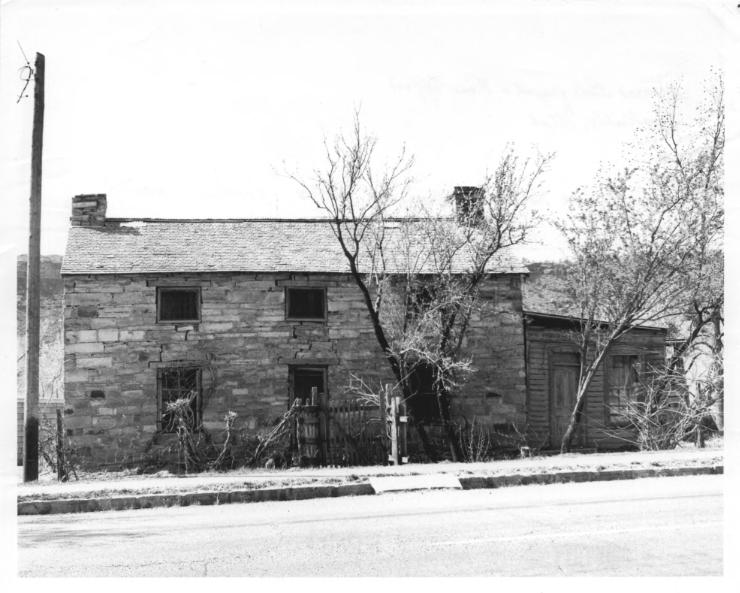
WASHINGTON COUNTY HISTORICAL SOCIETY (Washington County, Utah)
DESERET TELEGRAPH AND POST OFFICE
Rockville, Utah
LOCATION
91 West Main Street (between Bennett Lane and Center Street)Rockville UT
37° 9' 38.99" North, 113° 2' 34" West
HISTORY
In 1864 Edward Huber built a rectangular rock house of red sandstone in Rockville, Utah. It was one of the community's finest early homes. It still stands today. Although vacant, it is generally solid. The gabled roof has been maintained to preserve the home.To the west, a small frame clapboard office, about 19' by 12' with a shed-type roof, was built during the mid-1870's, It served as both a telegraph office and post office for a number of years. The building still stands, though it is in need of repairs. The current owner, Mr. Glen Steed, has put a sheet metal shed over the structure to protect it. Preservation plans include restoration and renovation of both the rock house and the office. A frame shed has also been added to the rear of the rock house.
Communication in early Utah was a difficult and time-consuming task. With the completion of the Transcontinental Telegraph line in Salt Lake City, October 23, 1861, the Mormons had instantaneous contact with the outside world. They desired next to put the miracle to use in Utah.
Almost immediately plans were made to build a telegraph line from Logan in the north to St. George in the south. However, the shortages of material occasioned by the Civil War forced postponement of the line. Later it was built with "war surplus" purchased from the federal government.
During the winter of 1865-1866, plans for its construction were revived. Cash tithing was accumulated to purchase wire and insulators for the 500 miles of line. A telegrapher's school, taught by John C, Clawes, was opened in Salt Lake City to train operators. Each area serviced by the line was asked to send an operator to the school. In many instances young men and women were "called" to this assignment. Their salaries, later, came from donations collected for that purpose.
To finance construction, the Deseret Telegraph Company was organized March 21, 1867 with a stock issue of $100,000. In addition, each valley was expected to provide labor organized and directed by the L.D.S. Church Priesthood. Poles were cut, hauled and set, so that by the time Horace D. Height's ox teams arrived in October 1866 with supplies, the lines were ready for them. By January 10, 1867, the St. George office was open. When completed, the system was appraised at about $500,000.
Soon after the branch telegraph lines were opened. One of these led from Toquerville in southern Utah, southeast to Rockville and then south and east to Windsor Castle (Pipe Springs) by December 1871. This was Arizona's first telegraph office. The line continued north to Kanab and on to Long Valley. The Rockville Station became an important link in the telegraph extention to the east Pipe Springs and Kanab where the Navajo Indian raiders were first intercepted when raiding the Mormon communities.
Although one reference suggests that Erastus Snow, in St. George, received a "telegram" from Rockville as early as November 22, 1868, it is believed that the "express" actually came from Toquerville, on the main southern line, that someone rode from Rockville to Toquerville to send the telegram.
The Deseret News (December 20, 1871) records that the telegraph office was first opened in mid-December, 1871, in "Brother Charles N. Smith's Parlor. Messrs. Scipio Kenner and Gerana Bebee. Operators. The citizens of course are much pleased." Smith's home seems to have been a sawed-log structure.
A few years later a telegraph office was built and attached to the west end of the old rock house that Edward Huber (or Hubert) had built in 1864. Both structures are included in the site designation. The little building was used as a Telegraph and Post Office for several decades. In 1903 the Deseret Telegraph Company had discontinued its services in southern Utah.
Most of the company had been sold to Western Union earlier. At its height, the church owned Deseret Telegraph Company, served all of Utah, and interlocked with Mormon settlements in Arizona, Nevada, and Idaho, Its more than 1,000 miles of lines were built primarily to serve as a communications medium for the Mormon people. Only where it served "gentiles" did it "turn a profit." This little office and rock house at Rockville recall this distinctive part of western and Mormon history.
Commentary by Mary Phoenix:
The old Telegraph office in Rockville is a reminder of how isolated the pioneers felt before its advent, especially in those settlements "up the river".
Although the transcontinental telegraph system reached Utah in 1860, it did not get to southern Utah until 1865. In that year, Erastus Snow wrote a letter to Brigham Young apologizing for being able to get only $683.33 in cash donations towards getting the line extended to St. George. However, he did receive additional pledges of labor and poles; it is believed that the impoverished people wanted the line as rapidly as possible in order to be in contact with their beloved leader.
On January 15, 1867, the telegraph line reached St. George. The first message was sent by Brigham Young, congratulating the people of the community for their hard work. He also suggested that each community desiring telegraphic service should select a young person to take the operator training course in Salt Lake as if they were serving a mission.
Telegraph service probably came to Rockville soon after the St. George connection was in place, as we know that Brigham Young received a communication from there in 1868. The office was housed in a frame addition to a rock house Edward Huber had built in 1864, a sign over the door proclaiming that this was the Deseret Telegraph and Post Office. Some oldtimers contend that it was a daughter of the Huber family who served as the first telegrapher.
There is no proof of the time the line was disconnected, possibly around the turn of the century, but we do know the building was used as a home by the Stout and DeMille families.
In recent years, the building was purchased by Roy Simmons, chairman of the board of Zion's First National Bank. He has restored it and furnished it with period furniture.
Put on the National Register of Historic Places (#1972001263) on Februrary 23, 1972.
PHOTOS
 Front of the Rock House and Deseret Telegraph & Post Office looking south, 2/23/1972 |
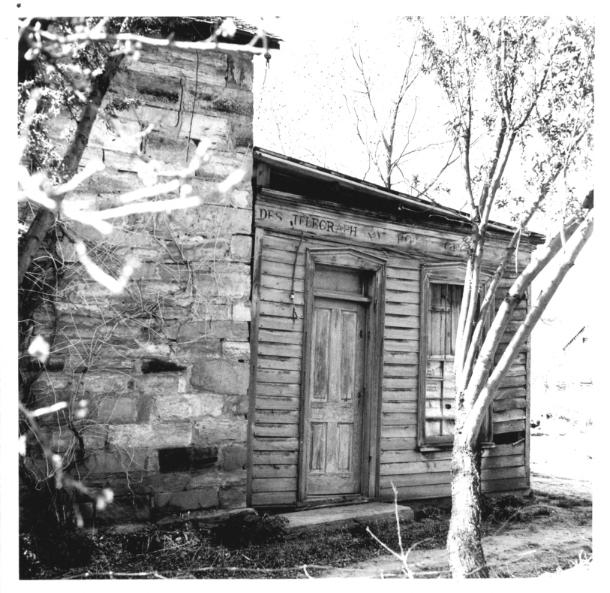 Front of the Deseret Telegraph & Post Office looking south, 2/23/1972 |
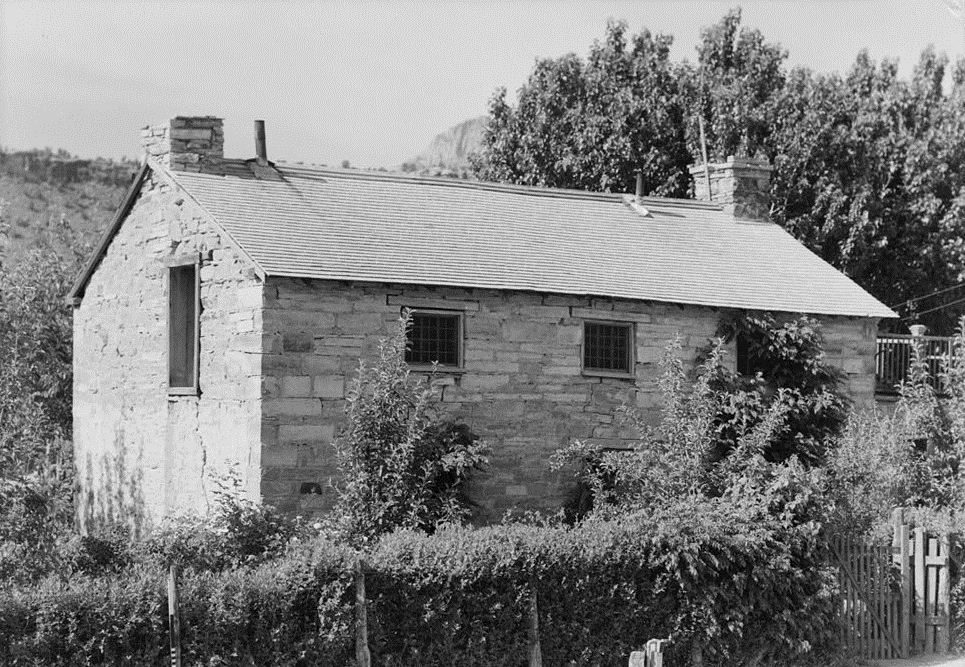 East and north sides, 5/19/1940 |
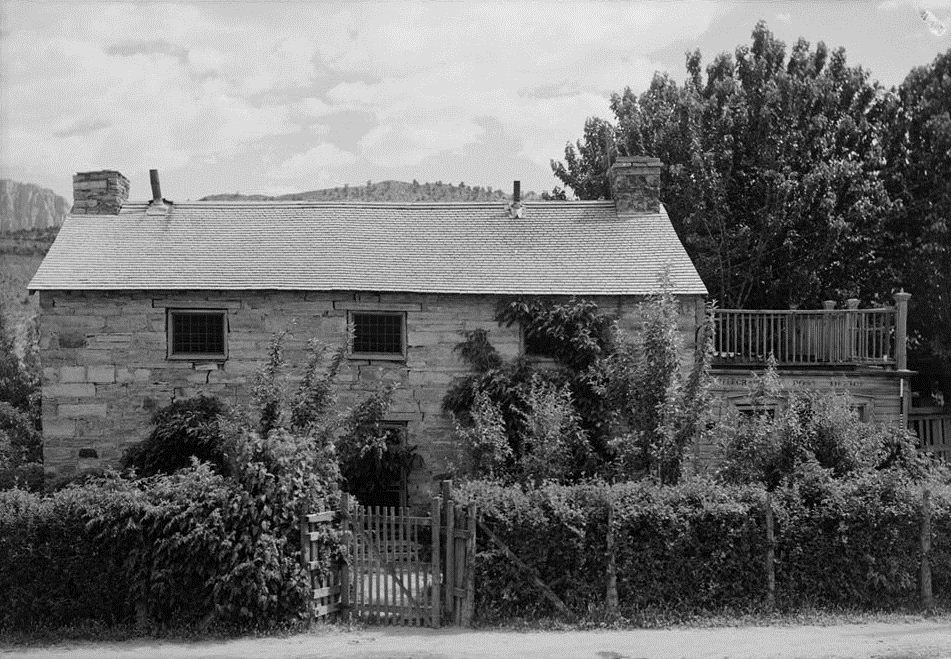 North/front side, 5/19/1940 |
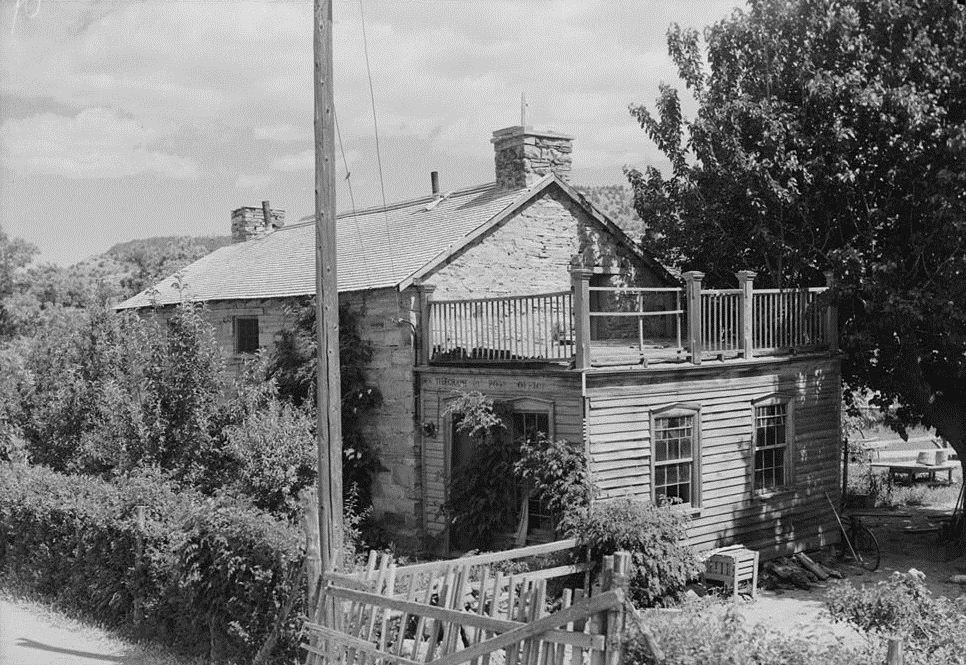 North and west sides, 5/19/1940 |
WCHS photos:
WCHS-00569 Jon Bowcutt sketch of the rock house
Other photos on the web:
Photos from the National Register of Historic Places nomination form, 2/23/1972 (see above)
HABS photo of the front (north) face of the Deseret Telegraph and Post Office, 5/19/1940 (see above)
HABS photo of the north and east sides of the Deseret Telegraph and Post Office, 5/19/1940 (see above)
HABS photo of the north and west sides of the Deseret Telegraph and Post Office, 5/19/1940 (see above)
HABS drawing of the location of the Deseret Telegraph and Post Office
HABS drawing of the first floor plan of the Deseret Telegraph and Post Office
HABS drawing of the second floor plan of the Deseret Telegraph and Post Office
HABS drawing of the north/front and south/rear sides of the Deseret Telegraph and Post Office
HABS drawing of east and west sides of the Deseret Telegraph and Post Office
HABS drawing of north/front side of the west wing of the Deseret Telegraph and Post Office
HABS drawing of the front door details of the Deseret Telegraph and Post Office
HABS drawing of the Room #2 mantle and cabinet details of the Deseret Telegraph and Post Office
REFERENCES
Historical Buildings of Washington County (Volume 2), pp. 30-31.Library of Congress, Historic American Buildings Survey, Deseret Telegraph and Post Office
Call Number: HABS UTAH,27-ROCVI,1-
Survey number HABS UT-36-U-4
National Register of Historic Places, Inventory - Nomination Form